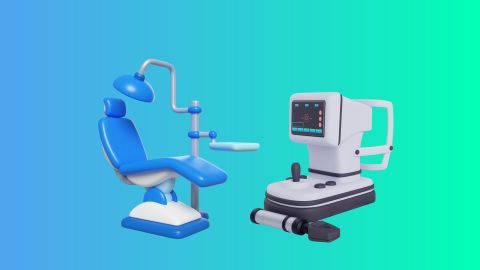To make these critical machines more affordable for your healthcare facility and improve access to early diagnosis, use our medical equipment finance facility. Check your medical equipment finance eligibility now.
Types of mammography machines
Mammography machines come in various types depending on their imaging technology, display capabilities, and application focus. Each type has its own set of benefits suited for different healthcare settings, ranging from basic screenings to advanced diagnostic procedures.- Film-screen mammography – Traditional analogue machines that use X-ray film to capture images. Less commonly used today due to digitisation.
- Digital mammography – Uses digital detectors instead of film, offering better image quality, faster processing, and easier storage.
- 3D tomosynthesis (Digital Breast Tomosynthesis) – Captures multiple breast images from different angles to create a 3D image, improving accuracy in detecting abnormalities.
- Portable mammography machines – Designed for mobile diagnostic units, often used in rural areas or community outreach programmes.
- Contrast-enhanced mammography – Combines standard digital mammography with contrast dyes to better highlight abnormalities, especially in dense breast tissues.
How does a mammography machine work?
Mammography machines function by using controlled doses of X-rays to produce high-resolution images of breast tissue. The process is non-invasive and takes only a few minutes, making it ideal for regular screenings.- Patient positioning – The patient stands or sits while one breast is placed on a flat surface of the imaging unit.
- Compression – A compression paddle gently presses the breast to spread tissue evenly and reduce movement for clear imaging.
- X-ray exposure – The machine emits a low-dose X-ray beam through the breast to capture internal images.
- Image capture – Detectors collect the X-rays and convert them into either film (analogue) or digital images.
- Review and diagnosis – Radiologists examine the images for signs of lumps, masses, or irregularities and recommend further action if needed.
Key features of a mammography machine
Mammography machines are equipped with advanced features to ensure accuracy, safety, and patient comfort. These features differ by model and brand, offering a range of functionalities for various diagnostic needs.- Low-dose radiation – Ensures minimal radiation exposure while maintaining image clarity.
- Automatic breast compression – Reduces discomfort and provides uniform tissue spread for better imaging.
- High-resolution detectors – Produces detailed images, especially in digital and 3D mammography.
- Digital display and storage – Allows radiologists to zoom, adjust contrast, and store images for long-term patient records.
- Integrated computer-aided detection (CAD) – Assists radiologists by highlighting potential areas of concern.
- Ergonomic design – Ensures ease of use and comfort for both operator and patient, including height-adjustable platforms.
Mammography machine price in India
The price of mammography machines in India varies based on the type, brand, technology, and additional features. Basic analogue models are more affordable, while digital and 3D machines come at a premium due to their superior imaging capabilities. Below is a general price estimate:| Type of mammography machine | Price range (Approximate) |
| Analogue (Film-screen) machine | Rs. 15,00,000 – Rs. 25,00,000 |
| Digital mammography machine | Rs. 30,00,000 – Rs. 60,00,000 |
| 3D tomosynthesis machine | Rs. 75,00,000 – Rs. 1,50,00,000 |
| Portable mammography machine | Rs. 12,00,000 – Rs. 35,00,000 |
| Contrast-enhanced mammography system | Rs. 90,00,000 – Rs. 1,80,00,000 |
Things to consider before buying a mammography machine
Investing in a mammography machine requires careful assessment of clinical needs, budget, and long-term usage. Indian healthcare providers must evaluate various technical, operational, and compliance factors to ensure optimal performance and return on investment.- Type of machine required – Choose between analogue, digital, or 3D based on the clinic’s diagnostic focus.
- Patient volume – Higher capacity machines are ideal for diagnostic centres handling large patient loads.
- Image quality – Prioritise models with high-resolution imaging and support for digital archiving.
- Software integration – Ensure compatibility with PACS, RIS, and hospital information systems.
- Radiation safety – Confirm the device adheres to AERB norms and offers low-dose imaging.
- Installation and space – Evaluate space availability and whether the machine requires wall mounting or floor support.
- Training and support – Opt for vendors that offer training sessions, demonstrations, and post-installation technical assistance.
Maintenance tips for mammography machine
Maintaining a mammography machine is vital to ensure consistent image quality, patient safety, and prolonged equipment life. Regular upkeep reduces downtime and enhances overall reliability.- Daily cleaning – Wipe all patient contact surfaces with approved disinfectants to maintain hygiene.
- Calibration checks – Perform routine calibration to maintain image accuracy and alignment.
- Inspect compression paddles – Regularly examine for wear or cracks and replace when necessary.
- Software updates – Install the latest firmware to improve system performance and security.
- Check radiation output – Monitor and adjust X-ray exposure levels periodically as per AERB guidelines.
- Schedule professional servicing – Have qualified engineers inspect the machine bi-annually for preventive maintenance.
Financing options for mammography machine
Given the high cost of advanced imaging equipment, many healthcare providers in India opt for financing to make purchases more manageable. Bajaj Finserv offers specialised medical equipment finance solutions tailored for diagnostic centres and hospitals.These plans include:
Loans up to Rs. 30 core – Covers full or partial cost of premium machines.
Flexible repayment tenures – Choose EMIs ranging from 12 to 84 months.
Collateral-free options – No need to pledge assets or clinic property.
Quick approval and disbursal – Funds can be credited within 48 hours* of approval.
Minimal documentation – Hassle-free digital application process with basic paperwork.
Pre-approved offers – Faster access for existing customers with tailored interest rates.




